These archive pages are provided in order to make it easier for you to find items
that you remember seeing on the Airplanes and Rockets homepage. Of course probably
the easiest way to find anything on the website is to use the "Search AAR" box at
the top of every page.
1 |
2 |
3 |
4 |
5 |
6 |
7 |
8 |
9 |
10 |
11 |
12 |
13 |
14 |
15 |
16 |
17 |
18 |
19 |
20
21 |
22 |
23 |
24 |
25 |
26 |
27 |
28 |
29 |
30 |
31 |
32 | 33

 In 1956 when this
Northern Minx
article and plans appeared in Young Men magazine, state of the art radio
control (R/C) was still composed of vacuum tubes and discrete components, usually
connected together via point-to-point wiring. Batteries were of the lead-acid type
for the transmitter and carbon or alkaline for the airborne receiver. As you might
guess, that resulted in heavy models which needed to be relatively large in order
to keep the wing loading down. Northern Minx only had a 48-inch wingspan, and used
a simple one-tube receiver with a rubber-powered escapement for channel control
of both the rudder and the elevator. The plans show only the rudder control installation,
and the photos appear to only show a single escapement, though. The builder just
about needed to use a shoe horn to squeeze all that in the fuselage. Interestingly,
the Northern Minx has a break-away nose section containing the firewall, engine,
fuel tank, propeller, spinner, and cowling... In 1956 when this
Northern Minx
article and plans appeared in Young Men magazine, state of the art radio
control (R/C) was still composed of vacuum tubes and discrete components, usually
connected together via point-to-point wiring. Batteries were of the lead-acid type
for the transmitter and carbon or alkaline for the airborne receiver. As you might
guess, that resulted in heavy models which needed to be relatively large in order
to keep the wing loading down. Northern Minx only had a 48-inch wingspan, and used
a simple one-tube receiver with a rubber-powered escapement for channel control
of both the rudder and the elevator. The plans show only the rudder control installation,
and the photos appear to only show a single escapement, though. The builder just
about needed to use a shoe horn to squeeze all that in the fuselage. Interestingly,
the Northern Minx has a break-away nose section containing the firewall, engine,
fuel tank, propeller, spinner, and cowling...
 "Astronomers at the iconic
Arecibo Observatory in Puerto Rico have revised their plans for a telescope
to replace the original facility, which dramatically collapsed in 2020. The so-called
Next Generation Arecibo Telescope (NGAT) would, if funded, involve building a phased
array of small parabolic antennas to carry out pioneering research to maintain the
island's position at the forefront of astronomy. The Arecibo Observatory, which
first opened in 1963, is located in a natural bowl and was used for research into
radio astronomy, planetary and space studies as well as atmospheric science. But
on 1 December 2020 the radio telescope's suspended platform - with its Gregorian
dome focus and a plethora of instrumentation - fell after multiple suspension cables
failed. The 900-tonne platform crashed into the 305 m dish, which lies almost
140 m below, destroying parts of it. Despite the damage, the National Science
Foundation (NSF), which funds the observatory, decided it would not close the site..." "Astronomers at the iconic
Arecibo Observatory in Puerto Rico have revised their plans for a telescope
to replace the original facility, which dramatically collapsed in 2020. The so-called
Next Generation Arecibo Telescope (NGAT) would, if funded, involve building a phased
array of small parabolic antennas to carry out pioneering research to maintain the
island's position at the forefront of astronomy. The Arecibo Observatory, which
first opened in 1963, is located in a natural bowl and was used for research into
radio astronomy, planetary and space studies as well as atmospheric science. But
on 1 December 2020 the radio telescope's suspended platform - with its Gregorian
dome focus and a plethora of instrumentation - fell after multiple suspension cables
failed. The 900-tonne platform crashed into the 305 m dish, which lies almost
140 m below, destroying parts of it. Despite the damage, the National Science
Foundation (NSF), which funds the observatory, decided it would not close the site..."
 Website visitor Kenneth E. wrote to say
that he is working to build a complete collection of the Tenderfoot models that
were published in the Academy of Model Aeronautics' American Aircraft Modeler
magazine. The Tenderfoot series was an attempt to provide motivation to young newcomers
to the hobby. They were a mix of freeflight rubber powered airplanes and helicopters,
gliders, and ¼A & ½A control line designs that built quickly,
simply, and cheaply. Kenneth requested reprints of the following three models: the
½A C/L Saucerer from January 1970, the FF HLGs
Bonanza and Mustang
(this article) from January 1971, and the FF rubber Clodhopper from February 1973... Website visitor Kenneth E. wrote to say
that he is working to build a complete collection of the Tenderfoot models that
were published in the Academy of Model Aeronautics' American Aircraft Modeler
magazine. The Tenderfoot series was an attempt to provide motivation to young newcomers
to the hobby. They were a mix of freeflight rubber powered airplanes and helicopters,
gliders, and ¼A & ½A control line designs that built quickly,
simply, and cheaply. Kenneth requested reprints of the following three models: the
½A C/L Saucerer from January 1970, the FF HLGs
Bonanza and Mustang
(this article) from January 1971, and the FF rubber Clodhopper from February 1973...
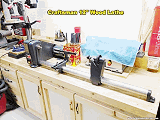 My introduction to using a wood lathe was
my high school wood shop class in my Junior year (circa 1974-1975) at Southern Senior
High in Harwood, MD. Mr. Charles Smith was the teacher. I have him to thank
for imparting a lifelong love for woodworking. Back in those days, we respected
teachers by addressing them Mr., Mrs., or Ms. Surprisingly, about a decade after
graduating, I ran into Mr. Smith at AACC while taking a class toward my electrical
engineering degree (he was not in my class). The wood shop at Robins AFB was well-equipped,
and include a wood lathe. I used it to turn a couple lamps from blocks of oak provided
by a Sgt. Eddie Nugent from my radar shop, who had cut down a tree a year or so
earlier. One of the two, which incorporated a burnt-out thyratron tube from the
S-band search radar, disappeared decades ago. I gave it to Melanie as a Christmas
present before we got married (in 1983). The other oak lamp is still around today.
After getting out of the USAF in 1982, I bought a
Craftsman 12"
wood lathe from the Sears store in Parole Plaza, in Annapolis, Maryland. When
Melanie and I got married, I set it up in the basement work shop of our tiny Cade
Cod house in Arnold, Maryland. You can also see in the photo my first Craftsman
radial arm saw, also bought at the Parole Plaza Sears store. After four decades
of moving from place to place many times, I still have a Craftsman radial arm saw... My introduction to using a wood lathe was
my high school wood shop class in my Junior year (circa 1974-1975) at Southern Senior
High in Harwood, MD. Mr. Charles Smith was the teacher. I have him to thank
for imparting a lifelong love for woodworking. Back in those days, we respected
teachers by addressing them Mr., Mrs., or Ms. Surprisingly, about a decade after
graduating, I ran into Mr. Smith at AACC while taking a class toward my electrical
engineering degree (he was not in my class). The wood shop at Robins AFB was well-equipped,
and include a wood lathe. I used it to turn a couple lamps from blocks of oak provided
by a Sgt. Eddie Nugent from my radar shop, who had cut down a tree a year or so
earlier. One of the two, which incorporated a burnt-out thyratron tube from the
S-band search radar, disappeared decades ago. I gave it to Melanie as a Christmas
present before we got married (in 1983). The other oak lamp is still around today.
After getting out of the USAF in 1982, I bought a
Craftsman 12"
wood lathe from the Sears store in Parole Plaza, in Annapolis, Maryland. When
Melanie and I got married, I set it up in the basement work shop of our tiny Cade
Cod house in Arnold, Maryland. You can also see in the photo my first Craftsman
radial arm saw, also bought at the Parole Plaza Sears store. After four decades
of moving from place to place many times, I still have a Craftsman radial arm saw...
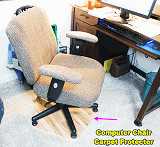 With as expensive as carpet is these days
(even cheap carpet is expensive), protecting it from the ravages of a computer chair
is essential for preservation. Casters wreak havoc with carpet, and even if you
replace the castors with fixed feet (w/ or w/o Teflon bottoms), deep depressions
are formed. One solution is too buy one of the plastic carpet protectors, but they're
big and ugly. Nice ones are available, but they're usually very expensive. I have
seen picture of very nice rectangular wooden surfaces people have built to allow
the chair to roll, but my space is cramped. All I need is a compact surface to contain
the chair feet without requiring the chair to roll. Since the seat swivels, getting
in and out of it is simple enough. My solution is shown in the photos. It did not
take long to construct, and is as diminutive as possible, being just large enough
to cover the foot span. The base of the
computer chair carpet
protector is cut from 1/2" furniture grade plywood... With as expensive as carpet is these days
(even cheap carpet is expensive), protecting it from the ravages of a computer chair
is essential for preservation. Casters wreak havoc with carpet, and even if you
replace the castors with fixed feet (w/ or w/o Teflon bottoms), deep depressions
are formed. One solution is too buy one of the plastic carpet protectors, but they're
big and ugly. Nice ones are available, but they're usually very expensive. I have
seen picture of very nice rectangular wooden surfaces people have built to allow
the chair to roll, but my space is cramped. All I need is a compact surface to contain
the chair feet without requiring the chair to roll. Since the seat swivels, getting
in and out of it is simple enough. My solution is shown in the photos. It did not
take long to construct, and is as diminutive as possible, being just large enough
to cover the foot span. The base of the
computer chair carpet
protector is cut from 1/2" furniture grade plywood...
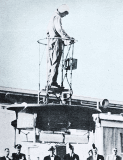 A lot of wild and zany ideas for flying
machines have been tried over the years. Most, if not all, of them could probably
be coaxed into flying with modern computer-controlled stabilization and navigations
systems that use fast-reacting powerplants, sensitive accelerometers and position
sensors. For anything other than stable platforms, human pilots just could not provide
control - at least on an extended basis and under adverse weather conditions. This
"flying platform"
by Hiller Helicopters is one such example. It appeared in the May 1957 issue of
American Modeler magazine. Piloting it was essentially the same as with the Lunar
Lander... A lot of wild and zany ideas for flying
machines have been tried over the years. Most, if not all, of them could probably
be coaxed into flying with modern computer-controlled stabilization and navigations
systems that use fast-reacting powerplants, sensitive accelerometers and position
sensors. For anything other than stable platforms, human pilots just could not provide
control - at least on an extended basis and under adverse weather conditions. This
"flying platform"
by Hiller Helicopters is one such example. It appeared in the May 1957 issue of
American Modeler magazine. Piloting it was essentially the same as with the Lunar
Lander...
 "Known officially as the
Global Combat Air Programme (GCAP), the flagship future air defence project
recently became a trilateral endeavour between the UK, Italy and Japan. According
to the MOD, the three partners will now 'progress the maturity of more than 60 cutting-edge
technology demonstrations, digital concepts and new technologies,' with a view to
a finished fighter taking to the skies by 2035. 'The next tranche of funding for
future combat air will help fuse the combined technologies and expertise we have
with our international partners - both in Europe and the Pacific - to deliver this
world-leading fighter jet by 2035, protecting our skies for decades to come,' said
defence secretary Ben Wallace. The MOD says Tempest is planned to be an innovative
stealth fighter with supersonic capability, equipped with advanced sensing..." "Known officially as the
Global Combat Air Programme (GCAP), the flagship future air defence project
recently became a trilateral endeavour between the UK, Italy and Japan. According
to the MOD, the three partners will now 'progress the maturity of more than 60 cutting-edge
technology demonstrations, digital concepts and new technologies,' with a view to
a finished fighter taking to the skies by 2035. 'The next tranche of funding for
future combat air will help fuse the combined technologies and expertise we have
with our international partners - both in Europe and the Pacific - to deliver this
world-leading fighter jet by 2035, protecting our skies for decades to come,' said
defence secretary Ben Wallace. The MOD says Tempest is planned to be an innovative
stealth fighter with supersonic capability, equipped with advanced sensing..."
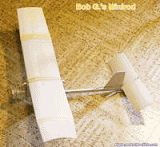 Website visitor Bob G. wrote to request
help with identifying a Cox .020-powered free flight model that he remembered seeing
in an old edition of American Aircraft Modeler modeler magazine. He couldn't
recall the name for sure, but gave a good enough description and a guess at the
approximate timeframe that I was able to find it for him - the "Mini−ROD." His completed
Mini−ROD is shown to the left. The finish has not yet been applied. You can see
where the wing panels are joined temporarily with masking tape. The horizontal stabilizer
is in its dethermalizer position. Wing and stabilizers are sheet balsa with airfoil-forming
ribs underneath. A Cox .020 engine will power the Mini−Rod. Bob is planning on building
a lot of the Tenderfoot series of models that appeared monthly back in the era... Website visitor Bob G. wrote to request
help with identifying a Cox .020-powered free flight model that he remembered seeing
in an old edition of American Aircraft Modeler modeler magazine. He couldn't
recall the name for sure, but gave a good enough description and a guess at the
approximate timeframe that I was able to find it for him - the "Mini−ROD." His completed
Mini−ROD is shown to the left. The finish has not yet been applied. You can see
where the wing panels are joined temporarily with masking tape. The horizontal stabilizer
is in its dethermalizer position. Wing and stabilizers are sheet balsa with airfoil-forming
ribs underneath. A Cox .020 engine will power the Mini−Rod. Bob is planning on building
a lot of the Tenderfoot series of models that appeared monthly back in the era...
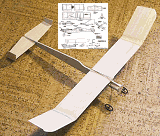 Airplanes and Rockets website visitor Bob
G. wrote to request that I post the articles for the Skyrida (October 1969 American
Aircraft Modeler) and for the Minirod (February 1969 AAM). He is on a mission to
build many of the "Tenderfoot" series of free flight models featured in American
Aircraft Modeler magazine back in the 1970s. "Chipper II" was published in the December
1964 issue of Model Airplane News magazine. The Academy of Model Aeronautics (AMA)
Plans Service can supply high quality plans for the Chipper II. Says
Bob, "I was building "Chipper II" (plans supplied by my brother-in-law) when you
posted the plans for "Skyrida". The "Chipper II" is largely complete. (photo attached)
It is the first engine powered plane that I've attempted in 40 years. I've applied
sanding sealer and dope. The only dope available here was clear, so I haven't painted
it, and may not. I doped it in the garage, and it took a couple of days for the
odors do dissipate, to my wife's disgust... Airplanes and Rockets website visitor Bob
G. wrote to request that I post the articles for the Skyrida (October 1969 American
Aircraft Modeler) and for the Minirod (February 1969 AAM). He is on a mission to
build many of the "Tenderfoot" series of free flight models featured in American
Aircraft Modeler magazine back in the 1970s. "Chipper II" was published in the December
1964 issue of Model Airplane News magazine. The Academy of Model Aeronautics (AMA)
Plans Service can supply high quality plans for the Chipper II. Says
Bob, "I was building "Chipper II" (plans supplied by my brother-in-law) when you
posted the plans for "Skyrida". The "Chipper II" is largely complete. (photo attached)
It is the first engine powered plane that I've attempted in 40 years. I've applied
sanding sealer and dope. The only dope available here was clear, so I haven't painted
it, and may not. I doped it in the garage, and it took a couple of days for the
odors do dissipate, to my wife's disgust...
 Over time, our (Melanie and me) Peanuts collection
of memorabilia has grow from the few items she had left over from her girlhood to
complete sets. She had the Hungerford Linus and Sally, so we still needed to find
Schroeder, Lucy, Charlie Brown, Pigpen, and Snoopy. Everything was procured via
eBay auctions. It took a lot of patience to be able to get good quality items at
an affordable price. The "Peanuts: The Art of Charles M. Schulz" book was very helpful
in identifying which Peanuts memorabilia items were made. The author mentioned that
the rarest Hungerford piece was the piano that came with Schroeder, so a saved search
was placed on eBay and after about a year, one came up for auction. We paid less
than $100 for it back around 2010. We're still in need of Lucy, Charlie Brown, Pigpen,
and Snoopy. Please let me know if you have these that you are will to sell at a
reasonable price... Over time, our (Melanie and me) Peanuts collection
of memorabilia has grow from the few items she had left over from her girlhood to
complete sets. She had the Hungerford Linus and Sally, so we still needed to find
Schroeder, Lucy, Charlie Brown, Pigpen, and Snoopy. Everything was procured via
eBay auctions. It took a lot of patience to be able to get good quality items at
an affordable price. The "Peanuts: The Art of Charles M. Schulz" book was very helpful
in identifying which Peanuts memorabilia items were made. The author mentioned that
the rarest Hungerford piece was the piano that came with Schroeder, so a saved search
was placed on eBay and after about a year, one came up for auction. We paid less
than $100 for it back around 2010. We're still in need of Lucy, Charlie Brown, Pigpen,
and Snoopy. Please let me know if you have these that you are will to sell at a
reasonable price...
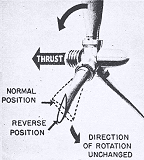 At the time this "Dual
Rotation-Reverse Thrust Propeller" article appeared in Flying Age magazine
in 1945, the jet-engine-powered aircraft were still mostly in the developmental
stage, although both Axis and Allied countries had managed to deploy a design or
two at the tail end of World War II. Commercial and military aircraft had been
using variable pitch propellers for a long time, even with reverse pitch for aerodynamic
braking. The concept of coaxial, counter-rotating propellers was a relatively new
idea in terms of building and testing working models for full-scale aircraft. Four
primary advantages of the configuration were more thrust for a given projected propeller
area, and the reduction or even total elimination of the counter-torque associated
with a normal propeller, the reduction or total elimination of gyroscopic precession,
and the reduction or total elimination of p−factor. History shows that while the
counter-rotating propeller has been employed successfully in certain instances,
it has not enjoyed widespread acceptance - primarily due to cost and complexity... At the time this "Dual
Rotation-Reverse Thrust Propeller" article appeared in Flying Age magazine
in 1945, the jet-engine-powered aircraft were still mostly in the developmental
stage, although both Axis and Allied countries had managed to deploy a design or
two at the tail end of World War II. Commercial and military aircraft had been
using variable pitch propellers for a long time, even with reverse pitch for aerodynamic
braking. The concept of coaxial, counter-rotating propellers was a relatively new
idea in terms of building and testing working models for full-scale aircraft. Four
primary advantages of the configuration were more thrust for a given projected propeller
area, and the reduction or even total elimination of the counter-torque associated
with a normal propeller, the reduction or total elimination of gyroscopic precession,
and the reduction or total elimination of p−factor. History shows that while the
counter-rotating propeller has been employed successfully in certain instances,
it has not enjoyed widespread acceptance - primarily due to cost and complexity...
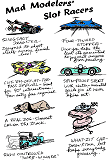 Slot car racing used to be a big deal back
before battery-powered radio control cars became inexpensive and readily available.
Many hobby shops, including one I used to frequent in Laurel, Maryland, had slot
car tracks set up for patrons to use. I think we paid something like a dollar for
half an hour. You could either bring your own car, or rent one from the hobby shop.
As with any activity, certain stereotypes are created and stick with slot car racers
and their creations. This set of comics from the September/October 1963 edition
of American Modeler magazine documents some of those things... Slot car racing used to be a big deal back
before battery-powered radio control cars became inexpensive and readily available.
Many hobby shops, including one I used to frequent in Laurel, Maryland, had slot
car tracks set up for patrons to use. I think we paid something like a dollar for
half an hour. You could either bring your own car, or rent one from the hobby shop.
As with any activity, certain stereotypes are created and stick with slot car racers
and their creations. This set of comics from the September/October 1963 edition
of American Modeler magazine documents some of those things...
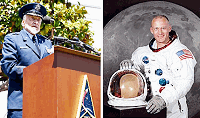 Apollo 11
astronaut Colonel Buzz Aldrin, the second
man to ever stand on the moon's surface - and the first ever to photograph another
man standing on the moon's surface - retired from the U.S. Air Force as a full
bird colonel. As the result of a distinguished career as a fighter pilot and test
pilot, and after earning a PhD in astronautics from MIT (thesis: "Line-of-sight guidance techniques
for manned orbital rendezvous"), and after flying as an astronaut in NASA's
Gemini space program, Buzz Aldrin was chosen as one of the three-member Apollo 11
crew (along with Neil Armstrong and Michael Collins). On May 5, 2023, at the Space
Systems Command Los Angeles Air Force Base, Buzz was honorarily promoted to the
rank of brigadier general (one-star) in the U.S. Space Command. Congratulations,
Brigadier General Buzz Aldrin! Apollo 11
astronaut Colonel Buzz Aldrin, the second
man to ever stand on the moon's surface - and the first ever to photograph another
man standing on the moon's surface - retired from the U.S. Air Force as a full
bird colonel. As the result of a distinguished career as a fighter pilot and test
pilot, and after earning a PhD in astronautics from MIT (thesis: "Line-of-sight guidance techniques
for manned orbital rendezvous"), and after flying as an astronaut in NASA's
Gemini space program, Buzz Aldrin was chosen as one of the three-member Apollo 11
crew (along with Neil Armstrong and Michael Collins). On May 5, 2023, at the Space
Systems Command Los Angeles Air Force Base, Buzz was honorarily promoted to the
rank of brigadier general (one-star) in the U.S. Space Command. Congratulations,
Brigadier General Buzz Aldrin!
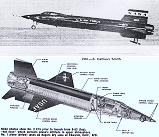 The X-15 was an experimental aircraft developed
by NASA and the U.S. Air Force in the 1950s and 1960s. It was a rocket-powered aircraft
designed to explore the high-speed and high-altitude flight regimes. The X-15 program
aimed to gather data on aerodynamics, structural heat resistance, and control systems
for future space and hypersonic vehicles. The X-15 was primarily built for research
purposes, aiming to push the boundaries of manned flight. It provided valuable data
on the effects of high speeds, altitudes, and temperatures on aircraft and human
physiology. The X-15 achieved impressive speeds, with its fastest recorded speed
being Mach 6.7 (about 4,520 miles per hour). It also reached altitudes of up to
354,200 feet. The X-15 was flown by a select group of experienced test pilots, including
Neil Armstrong. From 1959 to 1968, the X-15 completed a total of 199 flights... The X-15 was an experimental aircraft developed
by NASA and the U.S. Air Force in the 1950s and 1960s. It was a rocket-powered aircraft
designed to explore the high-speed and high-altitude flight regimes. The X-15 program
aimed to gather data on aerodynamics, structural heat resistance, and control systems
for future space and hypersonic vehicles. The X-15 was primarily built for research
purposes, aiming to push the boundaries of manned flight. It provided valuable data
on the effects of high speeds, altitudes, and temperatures on aircraft and human
physiology. The X-15 achieved impressive speeds, with its fastest recorded speed
being Mach 6.7 (about 4,520 miles per hour). It also reached altitudes of up to
354,200 feet. The X-15 was flown by a select group of experienced test pilots, including
Neil Armstrong. From 1959 to 1968, the X-15 completed a total of 199 flights...
 Who says
that supergenius astrophysicists don't have a sense of humor? Certainly not me,
and here's proof. A news story entitled "Gravitational
Lensing of Supernova Yields New Value for Hubble Constant," tells an amazing
account of how a group of researchers exploited the phenomenon of gravitational
lensing (a relatively new discovery) by a recently discovered supernova to calculate
a more accurate value for the Hubble constant (H0). Here's the hilarious
part: One of the three primary research groups in the quest for ever-improved Hubble
constant values calls itself
H0LiCOW (H0
Lenses in COSMOGRAIL's Wellspring). "A study
of how light from a distant supernova was gravitationally lensed as it travelled
to Earth has been used to calculate a new value for the Hubble constant - an important
parameter that describes the expansion of the universe ... The lumpy distribution
of mass in the cluster created a complex gravitational field that sent the supernova's
light along several different paths towards Earth. When the supernova was first
observed in 2014, it appeared as four points of light. As the four points faded,
a fifth appeared 376 days later. This light was delayed by the longer path it had
taken through the cluster. During those 376 days the universe had expanded, which
means that the wavelength of the late arriving light was redshifted..."
Holy cow, another
nonconstant constant! Who says
that supergenius astrophysicists don't have a sense of humor? Certainly not me,
and here's proof. A news story entitled "Gravitational
Lensing of Supernova Yields New Value for Hubble Constant," tells an amazing
account of how a group of researchers exploited the phenomenon of gravitational
lensing (a relatively new discovery) by a recently discovered supernova to calculate
a more accurate value for the Hubble constant (H0). Here's the hilarious
part: One of the three primary research groups in the quest for ever-improved Hubble
constant values calls itself
H0LiCOW (H0
Lenses in COSMOGRAIL's Wellspring). "A study
of how light from a distant supernova was gravitationally lensed as it travelled
to Earth has been used to calculate a new value for the Hubble constant - an important
parameter that describes the expansion of the universe ... The lumpy distribution
of mass in the cluster created a complex gravitational field that sent the supernova's
light along several different paths towards Earth. When the supernova was first
observed in 2014, it appeared as four points of light. As the four points faded,
a fifth appeared 376 days later. This light was delayed by the longer path it had
taken through the cluster. During those 376 days the universe had expanded, which
means that the wavelength of the late arriving light was redshifted..."
Holy cow, another
nonconstant constant!
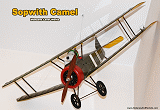 Melanie gave me a Peter Rake-designed
Sopwith Camel from Manzano Laser Works
short kit for Christmas 2008. The entire building process has been documented here.
The laser cut parts are very nice, as can be seen in these photos. There are a couple
places you can go to read construction articles on the Sopwith Camel, but they are
for radio control. My Camel was originally going to be built for control line, so
I figured it would be worth including some additional information here. I have since
then decided to use a 3−channel R/C setup. I planned at first to use the recommended
Graupner GR170323 motor/gearbox combination, but have since settled on an E−flite
Park 370 brushless outrunner motor to get the extra power. Either a 2−cell, 1500
mAh LiPo or a 3−cell, 1300 mAh LiPo battery will be used. Using an APC 10x4.7 e−propeller
and the 3−cell LiPo, the thrust-to-weight ratio on a full charge well exceeds 1:1.
The instructions and plans are very sparse, and leave a lot to the imagination regarding
the actual construction, so there are photos here that you will not find elsewhere... Melanie gave me a Peter Rake-designed
Sopwith Camel from Manzano Laser Works
short kit for Christmas 2008. The entire building process has been documented here.
The laser cut parts are very nice, as can be seen in these photos. There are a couple
places you can go to read construction articles on the Sopwith Camel, but they are
for radio control. My Camel was originally going to be built for control line, so
I figured it would be worth including some additional information here. I have since
then decided to use a 3−channel R/C setup. I planned at first to use the recommended
Graupner GR170323 motor/gearbox combination, but have since settled on an E−flite
Park 370 brushless outrunner motor to get the extra power. Either a 2−cell, 1500
mAh LiPo or a 3−cell, 1300 mAh LiPo battery will be used. Using an APC 10x4.7 e−propeller
and the 3−cell LiPo, the thrust-to-weight ratio on a full charge well exceeds 1:1.
The instructions and plans are very sparse, and leave a lot to the imagination regarding
the actual construction, so there are photos here that you will not find elsewhere...
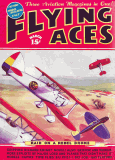 At first I was skipping over these over
these "All Questions Answered" columns that appeared monthly in Flying Aces
magazine, because I thought it was dumb to print responses to questions without
also printing the questions that elicited them. After finally reading this one from
the March 1937 issue, I realized that the questions can be inferred from the responses,
and the information contained in the responses was stuff that required someone with
an encyclopedic knowledge of the aeronautical field and/or someone with access to
scarce volumes of data. Although not explicitly attributed to him, I believe after
reading much of Joe Archibald's work (including the misadventures of Lt. Phineas
Pinkham and his "Happy Landings" column) that most, or maybe even all, of it was
provided by him. Mr. Archibald was himself a World War I flying ace with
a vast knowledge of airplane models, aeronautics, and aviation history... At first I was skipping over these over
these "All Questions Answered" columns that appeared monthly in Flying Aces
magazine, because I thought it was dumb to print responses to questions without
also printing the questions that elicited them. After finally reading this one from
the March 1937 issue, I realized that the questions can be inferred from the responses,
and the information contained in the responses was stuff that required someone with
an encyclopedic knowledge of the aeronautical field and/or someone with access to
scarce volumes of data. Although not explicitly attributed to him, I believe after
reading much of Joe Archibald's work (including the misadventures of Lt. Phineas
Pinkham and his "Happy Landings" column) that most, or maybe even all, of it was
provided by him. Mr. Archibald was himself a World War I flying ace with
a vast knowledge of airplane models, aeronautics, and aviation history...
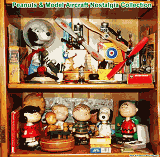 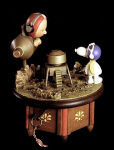 The Peanuts© comic strip, drawn by Charles
Schulz, has been my lifetime favorite. That it is also the world's favorite strip
is no wonder. Now that I have crossed the half-century threshold, I tend to look
back at the innocence and complexity of the themes with a perspective other than
simply entertainment - although I still thoroughly enjoy reading them just to get
a few good laughs. Along the way, I have managed to collect a few bits of memorabilia.
Melanie was a Peanuts fan as a child and actually still had some of her girlhood
collection. Part of her dowry when we married was a couple dozen Peanuts paperback
comic books, Charlie Brown, Lucy, and Snoopy Skediddlers, the Snoopy Christmas tree
ornament, a couple Peanuts banners, and a few other odds and ends. The rest of the
stuff like the Snoopy astronaut and the magazines with early Charles Schulz artwork
was purchased off of eBay. Schroeder, Lucy, and Snoopy Bobbleheads (aka Nodders)
were added in November 2012 as well as the Schroeder & Piano... The Peanuts© comic strip, drawn by Charles
Schulz, has been my lifetime favorite. That it is also the world's favorite strip
is no wonder. Now that I have crossed the half-century threshold, I tend to look
back at the innocence and complexity of the themes with a perspective other than
simply entertainment - although I still thoroughly enjoy reading them just to get
a few good laughs. Along the way, I have managed to collect a few bits of memorabilia.
Melanie was a Peanuts fan as a child and actually still had some of her girlhood
collection. Part of her dowry when we married was a couple dozen Peanuts paperback
comic books, Charlie Brown, Lucy, and Snoopy Skediddlers, the Snoopy Christmas tree
ornament, a couple Peanuts banners, and a few other odds and ends. The rest of the
stuff like the Snoopy astronaut and the magazines with early Charles Schulz artwork
was purchased off of eBay. Schroeder, Lucy, and Snoopy Bobbleheads (aka Nodders)
were added in November 2012 as well as the Schroeder & Piano...
 "JPL's
Ingenuity helicopter
is preparing for the 50th flight of its 5-flight mission to Mars. Flight 49, which
took place last weekend, was its fastest and highest yet - the little helicopter
flew 282 meters at an altitude of 16 meters, reaching a top speed of 6.50 meters
per second. Not a bad performance for a tech demo that was supposed to be terminated
two years ago. From here, things are only going to get more difficult for Ingenuity.
As the Perseverance rover continues its climb up Jezero crater's ancient river delta,
Ingenuity is trying its best to scout ahead. But, the winding hills and valleys
make it difficult for the helicopter to communicate with the rover, and through
the rover, to its team back on Earth. And there isn't a lot of time or room to spare,
because Ingenuity isn't allowed to fly too close to Perseverance..." "JPL's
Ingenuity helicopter
is preparing for the 50th flight of its 5-flight mission to Mars. Flight 49, which
took place last weekend, was its fastest and highest yet - the little helicopter
flew 282 meters at an altitude of 16 meters, reaching a top speed of 6.50 meters
per second. Not a bad performance for a tech demo that was supposed to be terminated
two years ago. From here, things are only going to get more difficult for Ingenuity.
As the Perseverance rover continues its climb up Jezero crater's ancient river delta,
Ingenuity is trying its best to scout ahead. But, the winding hills and valleys
make it difficult for the helicopter to communicate with the rover, and through
the rover, to its team back on Earth. And there isn't a lot of time or room to spare,
because Ingenuity isn't allowed to fly too close to Perseverance..."
 "Days of the Americans" is one chapter out
of a book entitled "The Big Distance." Per this article which appeared in the December
1945 issue of Flying Age magazine, "The Big Distance, the official story
prepared by the AAF, is to the struggle in the Pacific what Germany was to the European
phase of the war." Unlike the European Theater of World War II, much of the
populations of South Pacific islands were inhabited by people who were barely out
of the Stone Age in terms of cultural and scientific evolution. The arrival of Northern
hemisphere Western and European Anglo Saxons brought a culture of sophistication
never dreamed of by the backwards civilizations indigenous to the islands. That
was a common theme of the villages visited by the McHale's Navy crew in the 1960s
TV series. While reading the story, I was a bit taken aback by the narrative of
Americans having come to the island paradises and bringing their gigantic machines
and inexplicable habits, but then the author states, "There always will be a faction
among the elders who will attempt to establish the basic facts of the legend of
the Americans through use of pure logic, simply pointing out that if the Americans
had not been there, the Japs still would be. If the Americans weren't actually present,
the question will be posed... "Days of the Americans" is one chapter out
of a book entitled "The Big Distance." Per this article which appeared in the December
1945 issue of Flying Age magazine, "The Big Distance, the official story
prepared by the AAF, is to the struggle in the Pacific what Germany was to the European
phase of the war." Unlike the European Theater of World War II, much of the
populations of South Pacific islands were inhabited by people who were barely out
of the Stone Age in terms of cultural and scientific evolution. The arrival of Northern
hemisphere Western and European Anglo Saxons brought a culture of sophistication
never dreamed of by the backwards civilizations indigenous to the islands. That
was a common theme of the villages visited by the McHale's Navy crew in the 1960s
TV series. While reading the story, I was a bit taken aback by the narrative of
Americans having come to the island paradises and bringing their gigantic machines
and inexplicable habits, but then the author states, "There always will be a faction
among the elders who will attempt to establish the basic facts of the legend of
the Americans through use of pure logic, simply pointing out that if the Americans
had not been there, the Japs still would be. If the Americans weren't actually present,
the question will be posed...
 Even
though the U.S. Army Air Force and other research agencies around the world were
at the forefront of experimenting with remote control airplanes, helicopters, tanks,
trucks, cars, boats, and rockets, hobbyists were forging their own paths in the
electronic art. I did not know until reading this article that drones were flown
through the radiation field at the Bikini Atoll atom bomb test site for data collection.
In fact amateur radio operators have long had the privilege of broadcasting for
the purpose of remotely controlling a vehicle - the only scenario of Earth-based
transmission whereby the "control operator" is not required to identify his/her
call sign at an interval prescribed by the FCC (currently at least once every 10
minutes and at the end of the broadcast). Vintage modeling magazines have articles
on early
radio controlled (R/C) airplane experimentation. Target drones subject to remote
control were not just small models, but also full-size aircraft that were deemed
not airworthy enough to carry a human crew... Even
though the U.S. Army Air Force and other research agencies around the world were
at the forefront of experimenting with remote control airplanes, helicopters, tanks,
trucks, cars, boats, and rockets, hobbyists were forging their own paths in the
electronic art. I did not know until reading this article that drones were flown
through the radiation field at the Bikini Atoll atom bomb test site for data collection.
In fact amateur radio operators have long had the privilege of broadcasting for
the purpose of remotely controlling a vehicle - the only scenario of Earth-based
transmission whereby the "control operator" is not required to identify his/her
call sign at an interval prescribed by the FCC (currently at least once every 10
minutes and at the end of the broadcast). Vintage modeling magazines have articles
on early
radio controlled (R/C) airplane experimentation. Target drones subject to remote
control were not just small models, but also full-size aircraft that were deemed
not airworthy enough to carry a human crew...
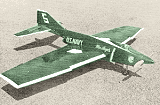 Website visitor Richard P. wrote to ask
for me to scan articles from the June 1971 edition of American Aircraft Modeler
magazine. The two articles, subtitled "A Study in Design Ideas," feature two control
line stunters, the F-4 Phantom
and the B8 Crusader, presented together as complimentary models but with varied
construction techniques. Designed and built by two separate modelers, Bill Suarez
and Vic Macaluso, respectively, they are similar in that both represented at the
time "the Navy's best current jet fighters," both have tricycle landing gear, have
wingspans in the 55-60" range, and use inverted mounting for a .35-size engine.
The big difference between the two is that the Phantom ahs a built-up wing while
the Crusader has a foam core wing... Website visitor Richard P. wrote to ask
for me to scan articles from the June 1971 edition of American Aircraft Modeler
magazine. The two articles, subtitled "A Study in Design Ideas," feature two control
line stunters, the F-4 Phantom
and the B8 Crusader, presented together as complimentary models but with varied
construction techniques. Designed and built by two separate modelers, Bill Suarez
and Vic Macaluso, respectively, they are similar in that both represented at the
time "the Navy's best current jet fighters," both have tricycle landing gear, have
wingspans in the 55-60" range, and use inverted mounting for a .35-size engine.
The big difference between the two is that the Phantom ahs a built-up wing while
the Crusader has a foam core wing...
 The AirplanesAnd The AirplanesAnd
Rockets.com website exists entirely on the support of its visitors by way of a small
percentage earned with your
Amazon.com purchases, which typically works out to less than
$10 per month. That barley covers the domain registration and secure server fees
for AirplanesAndRockets.com. If you plan to buy items via
Amazon.com, please click on this link to begin your shopping
session from here so that I get credit for it. Doing so does not cost you anything
extra. Thank you for your support.
 Some guy in the Netherlands has a collection
more than
230 classic autos, many in showroom condition, that have just gone up for auction.
I would love to be able to afford just one nice pickup truck from the 1960s or 1970s.
My 1st choice would be a 1952
Ford F−1 stepside like the one on the Sanford
and Son TV show (I have the DVD set). "An elderly car enthusiast's astonishing
collection of 230 rare classic cars has been discovered by a Dutch auction house,
and the lot, including European and American cars collectively worth millions, is
soon to be sold at auction. One particular, 'undeniably stylish and sophisticated'
sports car from the 1950s is expected to fetch in excess of 675,000 euros ($729,432).
Former professional car dealer Ad Palmen of the Netherlands, 82, had been collecting
cars for decades. He stored them in a church and two 'dry but dusty' warehouses
in Dordrecht until his ailing health forced him to sell them all ... Mr. Palmen
started collecting cars approximately 40 years ago, with a yellow Lancia B20 being
the first car..." Some guy in the Netherlands has a collection
more than
230 classic autos, many in showroom condition, that have just gone up for auction.
I would love to be able to afford just one nice pickup truck from the 1960s or 1970s.
My 1st choice would be a 1952
Ford F−1 stepside like the one on the Sanford
and Son TV show (I have the DVD set). "An elderly car enthusiast's astonishing
collection of 230 rare classic cars has been discovered by a Dutch auction house,
and the lot, including European and American cars collectively worth millions, is
soon to be sold at auction. One particular, 'undeniably stylish and sophisticated'
sports car from the 1950s is expected to fetch in excess of 675,000 euros ($729,432).
Former professional car dealer Ad Palmen of the Netherlands, 82, had been collecting
cars for decades. He stored them in a church and two 'dry but dusty' warehouses
in Dordrecht until his ailing health forced him to sell them all ... Mr. Palmen
started collecting cars approximately 40 years ago, with a yellow Lancia B20 being
the first car..."
 "The
Federal Communications Commission will officially launch its
Space Bureau tomorrow, reflecting the agency's reorganization to deal with increased
interest in satellite-based communications. Chairwoman Jessica Rosenworcel proposed
the reorganization late last year and the Commission unanimously approved it in
January. The change splits the International Bureau into two 'separate, cooperative
units' within the FCC: The Space Bureau, which will focus on 'policy and licensing
matters related to satellite and space-based communications and activities,' and
Office of International Affairs (OIA), which will coordinate FCC work with foreign
and international regulatory authorities. The FCC has already received applications
for 64,000 new satellites, indicating just how much the sector is booming - particularly
in the area of low-Earth orbit (LEO) satellites. In the coming years, tighter integration
between 5G terrestrial and non-terrestrial networks is expected to emerge. Early
use cases for smartphone-based satellite connectivity are already in play, such
as T-Mobile US' deal with Starlink to share spectrum..." "The
Federal Communications Commission will officially launch its
Space Bureau tomorrow, reflecting the agency's reorganization to deal with increased
interest in satellite-based communications. Chairwoman Jessica Rosenworcel proposed
the reorganization late last year and the Commission unanimously approved it in
January. The change splits the International Bureau into two 'separate, cooperative
units' within the FCC: The Space Bureau, which will focus on 'policy and licensing
matters related to satellite and space-based communications and activities,' and
Office of International Affairs (OIA), which will coordinate FCC work with foreign
and international regulatory authorities. The FCC has already received applications
for 64,000 new satellites, indicating just how much the sector is booming - particularly
in the area of low-Earth orbit (LEO) satellites. In the coming years, tighter integration
between 5G terrestrial and non-terrestrial networks is expected to emerge. Early
use cases for smartphone-based satellite connectivity are already in play, such
as T-Mobile US' deal with Starlink to share spectrum..."
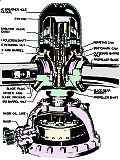 It really is amazing how quickly aeronautics
evolved in the mere four decades between when the Wright brothers first flew their
Flyer until when this 1945 issue of Flying Age magazine printed a
history of development of propellers. The technology went from fixed pitch,
hand-carved wooden models to variable pitch, machine formed and finished high strength
metal alloy variants. Those c1945 props needed to withstand the incredible forces
of not just 1000-plus horsepower engines, but the centrifugal force and bending
moments imposed on them by high speed rotation and rapid changes in axial orientation
as the airplanes they were attached to performed high−G maneuvers. Research and
development from American, European, Russian, Chinese, and Japanese engineers and
scientists are to be primarily credited... It really is amazing how quickly aeronautics
evolved in the mere four decades between when the Wright brothers first flew their
Flyer until when this 1945 issue of Flying Age magazine printed a
history of development of propellers. The technology went from fixed pitch,
hand-carved wooden models to variable pitch, machine formed and finished high strength
metal alloy variants. Those c1945 props needed to withstand the incredible forces
of not just 1000-plus horsepower engines, but the centrifugal force and bending
moments imposed on them by high speed rotation and rapid changes in axial orientation
as the airplanes they were attached to performed high−G maneuvers. Research and
development from American, European, Russian, Chinese, and Japanese engineers and
scientists are to be primarily credited...
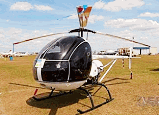 "The
Aerokopter AK1-3 is a Ukrainian-designed and built helicopter distributed by
Warsaw, Poland's Manufaktura Lotnicza as the Argon AK1-3 Sanka. The aircraft is
supplied as both a kit and a complete, ready-to-fly helicopter. In several Slavic
languages, Sanka is the term for sled. Designed to comply with Ukrainian AP-27 rules
- which approximate the European Aviation Safety Agency's (EASA) CS-27 standards
- the AK1-3 is a conventional helicopter featuring an enclosed, two-occupant cabin;
a single main rotor; and a boom-mounted anti-torque rotor. The aircraft is powered
by a four-cylinder, air-cooled, four-stroke, 156−horsepower Subaru EJ25 engine designed
to run on automotive gasoline..." "The
Aerokopter AK1-3 is a Ukrainian-designed and built helicopter distributed by
Warsaw, Poland's Manufaktura Lotnicza as the Argon AK1-3 Sanka. The aircraft is
supplied as both a kit and a complete, ready-to-fly helicopter. In several Slavic
languages, Sanka is the term for sled. Designed to comply with Ukrainian AP-27 rules
- which approximate the European Aviation Safety Agency's (EASA) CS-27 standards
- the AK1-3 is a conventional helicopter featuring an enclosed, two-occupant cabin;
a single main rotor; and a boom-mounted anti-torque rotor. The aircraft is powered
by a four-cylinder, air-cooled, four-stroke, 156−horsepower Subaru EJ25 engine designed
to run on automotive gasoline..."
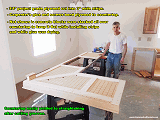 Here is the method I came up with to straighten
what were initially very
bowed (lengthwise)
and cupped (depthwise) laminate countertops. An Internet search on recommended
ways to correct it turned up nothing. Many suggested that with as severely curved
as mine were, the best thing to do is to discard them and buy new countertops. That
was not an option for two reasons. First, after the COVID scamdemic the cost was
double what it had been just two years prior. Second, the scamdemic, in early 2022,
was still causing a major shortage of building materials, so finding a suitable
selection was nearly impossible. Having been a woodworker for many decades, there
have been a few times I needed to remove warps, twists, or bows from wood surfaces.
Cutting a crosshatch pattern on the underside for stress relief and then flattening
and bracing the surface always did the trick. Attempting to flatten the countertop
by weighing down the edges and screwing the top to the base cabinets would not work
because the tension in the curve would likely have caused the laminate on the top
to split. Cutting slots in the bottom surface made the less-thick wood easily bend
back into a flat surface. The slots were cut about a third of the way through from
the bottom, and were spaced 2 inches apart... Here is the method I came up with to straighten
what were initially very
bowed (lengthwise)
and cupped (depthwise) laminate countertops. An Internet search on recommended
ways to correct it turned up nothing. Many suggested that with as severely curved
as mine were, the best thing to do is to discard them and buy new countertops. That
was not an option for two reasons. First, after the COVID scamdemic the cost was
double what it had been just two years prior. Second, the scamdemic, in early 2022,
was still causing a major shortage of building materials, so finding a suitable
selection was nearly impossible. Having been a woodworker for many decades, there
have been a few times I needed to remove warps, twists, or bows from wood surfaces.
Cutting a crosshatch pattern on the underside for stress relief and then flattening
and bracing the surface always did the trick. Attempting to flatten the countertop
by weighing down the edges and screwing the top to the base cabinets would not work
because the tension in the curve would likely have caused the laminate on the top
to split. Cutting slots in the bottom surface made the less-thick wood easily bend
back into a flat surface. The slots were cut about a third of the way through from
the bottom, and were spaced 2 inches apart...
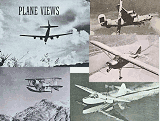 "Plane Views" was a monthly feature of
Flying Age magazine, with this installment being from the December 1945
issue. Flying Aces changed its name to Flying Age in the middle
of 1944, probably to focus on the rapidly advancing aeronautical technology prompted
by World War II. Whereas Flying Aces was full of fictional stories
of flying aces during World War I and the interim up though the middle of World
War II - along with plans for airplane models - Flying Age was essentially
an entirely new magazine with very little in the way of model aviation and none
of the adventure stories. Many Flying Aces readers were highly upset at
the extreme change, especially since it essentially abandoned the Flying Aces Club
as well. The Academy of Model Aeronautics (AMA) had no involvement with either the
Flying Aces or the Flying Age magazines. In fact, I don't recall
the AMA ever being mentioned. The AMA had its own magazine that went by various
titles over the years, including American Modeler, American Aircraft
Modeler, and its present incarnation, Model Aviation... "Plane Views" was a monthly feature of
Flying Age magazine, with this installment being from the December 1945
issue. Flying Aces changed its name to Flying Age in the middle
of 1944, probably to focus on the rapidly advancing aeronautical technology prompted
by World War II. Whereas Flying Aces was full of fictional stories
of flying aces during World War I and the interim up though the middle of World
War II - along with plans for airplane models - Flying Age was essentially
an entirely new magazine with very little in the way of model aviation and none
of the adventure stories. Many Flying Aces readers were highly upset at
the extreme change, especially since it essentially abandoned the Flying Aces Club
as well. The Academy of Model Aeronautics (AMA) had no involvement with either the
Flying Aces or the Flying Age magazines. In fact, I don't recall
the AMA ever being mentioned. The AMA had its own magazine that went by various
titles over the years, including American Modeler, American Aircraft
Modeler, and its present incarnation, Model Aviation...
 "No, it's not hypermodern art. This image,
generated by NASA's high-performance computers, shows a Transonic Truss Braced Wing
(TTBW) aircraft concept being tested in a virtual wind tunnel, showing how its wings
interact with the air around them. In this case, the dark red area along the front
of the wing represents higher-speed airflow as the TTBW's wings, which are thinner
than those of today's commercial airliners, pierce the air. The tan-colored area
shows the relatively smooth wake generated by the aerodynamic wings. A TTBW aircraft
produces less drag due to its longer, thinner wings supported by aerodynamic trusses.
In flight, it could consume up to 10% less jet fuel than a standard airliner. The
Advanced Supercomputing Division of NASA's Ames Research Center in California
created this image as part of an effort by the Transformational Tools and Technologies
project to develop computational tools for TTBW research..." "No, it's not hypermodern art. This image,
generated by NASA's high-performance computers, shows a Transonic Truss Braced Wing
(TTBW) aircraft concept being tested in a virtual wind tunnel, showing how its wings
interact with the air around them. In this case, the dark red area along the front
of the wing represents higher-speed airflow as the TTBW's wings, which are thinner
than those of today's commercial airliners, pierce the air. The tan-colored area
shows the relatively smooth wake generated by the aerodynamic wings. A TTBW aircraft
produces less drag due to its longer, thinner wings supported by aerodynamic trusses.
In flight, it could consume up to 10% less jet fuel than a standard airliner. The
Advanced Supercomputing Division of NASA's Ames Research Center in California
created this image as part of an effort by the Transformational Tools and Technologies
project to develop computational tools for TTBW research..."
 The "BS" part of this device's name must
refer to the FAA's outrageous requirement that R/C hobbyists carry identification
devices aboard every model - not just drones but even
gliders
and power planes. The $89 (+ tax and shipping) price tag is a far cry from the FAA's
promise of "inexpensive" devices. This is yet another unnecessary tax upon citizens.
"Dronetag has announced their 'Dronetag BS' system as a cost-effective method to
bring consumer UAVs into Remote ID compliance. Dronetag BS is, of course, short
for 'Dronetag Basic Solution,' though
the company is sure to draw in some eyes with their brash take on the normally staid
UAV market. The firm will offer Dronetag BS for an
introductory price of $49 upon its
May 22 drop date, offering the special for the first 24
hours of its release. For those that miss the intro rate, the standard retail price
will remain at $89. The firm obviously has its feet in the trenches with the average
drone pilot, admitting that many don't quite think much positive regarding the new
Remote ID regulations.
The Dronetag BS allows operators to easily bring their small aircraft into compliance
with a compact..." The "BS" part of this device's name must
refer to the FAA's outrageous requirement that R/C hobbyists carry identification
devices aboard every model - not just drones but even
gliders
and power planes. The $89 (+ tax and shipping) price tag is a far cry from the FAA's
promise of "inexpensive" devices. This is yet another unnecessary tax upon citizens.
"Dronetag has announced their 'Dronetag BS' system as a cost-effective method to
bring consumer UAVs into Remote ID compliance. Dronetag BS is, of course, short
for 'Dronetag Basic Solution,' though
the company is sure to draw in some eyes with their brash take on the normally staid
UAV market. The firm will offer Dronetag BS for an
introductory price of $49 upon its
May 22 drop date, offering the special for the first 24
hours of its release. For those that miss the intro rate, the standard retail price
will remain at $89. The firm obviously has its feet in the trenches with the average
drone pilot, admitting that many don't quite think much positive regarding the new
Remote ID regulations.
The Dronetag BS allows operators to easily bring their small aircraft into compliance
with a compact..."
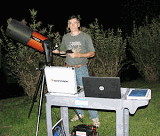 Here I am in my back yard in Erie, Pennsylvania,
"playing" with my newly acquired (in June)
Celestron NexStar 8SE telescope.
City lights are fairly bright here to the east and west, but farm land is to the
south and Lake Erie begins two miles to the north, so that limits the light pollution
somewhat. Erie is not that large of a city, so that also helps. Still, compared
to the truly dark skies in areas I have lived in Vermont and Colorado, the seeing
is noticeably bad. I haven't had a chance to try any of the filters that came with
the eyepiece and filter kit that came with the scope. I also bought a Celestron
NexImage camera for use with the telescope. It is only good for really bright objects
like planets and the moon, mainly because the stock interface does not allow long
time exposures. However, there is a hack online that modifies it for longer settings.
The pixel resolution... Here I am in my back yard in Erie, Pennsylvania,
"playing" with my newly acquired (in June)
Celestron NexStar 8SE telescope.
City lights are fairly bright here to the east and west, but farm land is to the
south and Lake Erie begins two miles to the north, so that limits the light pollution
somewhat. Erie is not that large of a city, so that also helps. Still, compared
to the truly dark skies in areas I have lived in Vermont and Colorado, the seeing
is noticeably bad. I haven't had a chance to try any of the filters that came with
the eyepiece and filter kit that came with the scope. I also bought a Celestron
NexImage camera for use with the telescope. It is only good for really bright objects
like planets and the moon, mainly because the stock interface does not allow long
time exposures. However, there is a hack online that modifies it for longer settings.
The pixel resolution...
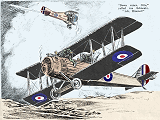 When I first began perusing the large collection
of Flying Aces magazines that I bought on eBay, I enthusiastically read all the
fictional adventure stories of, well, flying aces, like Richard "Dick" Night, Kerry
Keen (aka "The Griffon"), "G−2" secret agent Cap. Philip Strange, Battling Grogan
and his Dragon Squadron, and others. For some reason I skipped over the adventures
of
Lt. Phineas
Pinkham, of the 9th Pursuit Squadron. Maybe it was because of the way he was
drawn that I figured it was just a dumb story about a hayseed doofus and wouldn't
be very good. One day I decided to actually read through one of the stories, and
much to my surprise discovered that the series was as good as any of the other aforementioned
yarns - with a lot of humor to boot. Lt. Pinkham is sort of the Boonetown,
Iowa, World War II version of LA police detective Lt. Columbo (whose first
name we were never made privy to). As did I, people assume he is a bumbling fool
who couldn't figure out the simplest of schemes by nefarious evil-doers, but in
actuality he is an extremely clever strategist and prankster who, in the manner
of the famous Canadian Mountie Dudley Do−Right, "always get his man." See if you
agree... When I first began perusing the large collection
of Flying Aces magazines that I bought on eBay, I enthusiastically read all the
fictional adventure stories of, well, flying aces, like Richard "Dick" Night, Kerry
Keen (aka "The Griffon"), "G−2" secret agent Cap. Philip Strange, Battling Grogan
and his Dragon Squadron, and others. For some reason I skipped over the adventures
of
Lt. Phineas
Pinkham, of the 9th Pursuit Squadron. Maybe it was because of the way he was
drawn that I figured it was just a dumb story about a hayseed doofus and wouldn't
be very good. One day I decided to actually read through one of the stories, and
much to my surprise discovered that the series was as good as any of the other aforementioned
yarns - with a lot of humor to boot. Lt. Pinkham is sort of the Boonetown,
Iowa, World War II version of LA police detective Lt. Columbo (whose first
name we were never made privy to). As did I, people assume he is a bumbling fool
who couldn't figure out the simplest of schemes by nefarious evil-doers, but in
actuality he is an extremely clever strategist and prankster who, in the manner
of the famous Canadian Mountie Dudley Do−Right, "always get his man." See if you
agree...
 "Of all the elements in the periodic table,
silicon has the highest capacity for combining with lithium. It can hold ten times
more lithium ions than the graphite anodes common in today's lithium-ion batteries.
Several carmakers and battery startups are looking at silicon anodes for the next
generation of
long-range, lightweight EV batteries. And now Amprius Technologies in Fremont,
Calif. reports a silicon-anode battery with almost twice the energy density of most
EV batteries today. The new battery's record-high 500 Wh/kg energy density
was verified by Mobile Power Solutions, an independent test and verification lab
in Beaverton, Oregon. 'Typical batteries used by Tesla and others are in the 250
to 300 Wh/kg range,' says Ionel Stefan, CTO of Amprius. 'With our cells, you
will have double the driving range for the same vehicle weight. Or you could keep
the same range and have a lighter battery so the mileage efficiency of the car increases.'
But cars are further down the road for Amprius. The company is initially targeting
aviation applications geared towards defense..." "Of all the elements in the periodic table,
silicon has the highest capacity for combining with lithium. It can hold ten times
more lithium ions than the graphite anodes common in today's lithium-ion batteries.
Several carmakers and battery startups are looking at silicon anodes for the next
generation of
long-range, lightweight EV batteries. And now Amprius Technologies in Fremont,
Calif. reports a silicon-anode battery with almost twice the energy density of most
EV batteries today. The new battery's record-high 500 Wh/kg energy density
was verified by Mobile Power Solutions, an independent test and verification lab
in Beaverton, Oregon. 'Typical batteries used by Tesla and others are in the 250
to 300 Wh/kg range,' says Ionel Stefan, CTO of Amprius. 'With our cells, you
will have double the driving range for the same vehicle weight. Or you could keep
the same range and have a lighter battery so the mileage efficiency of the car increases.'
But cars are further down the road for Amprius. The company is initially targeting
aviation applications geared towards defense..."
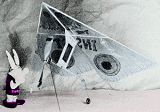 Here is the article and plans for the "Insect"
that I electronically scanned from my purchased copy of the April 1970 American
Aircraft Modeler magazine.
Rogallo Wings were
all the rage in the 1970s as hang gliding was really gaining in popularity, so the
modeling world joined in the fun. An article for the R/C Flexi-Flier, complete with
a G.I. Joe pilot, was published four years after this free flight model. Plans for
this fine model were drawn by Bill Warner. Because they spanned two pages, I had
to adjust the size and alignment a bit to get the halves to line up properly. They
were printed full-size in the magazine, so to get the right size when printing,
you will need to do some trial and error. There really is no need to even print
plans, because dimensions for the parasol components are shown, and the remaining
few pieces can be scaled accordingly... Here is the article and plans for the "Insect"
that I electronically scanned from my purchased copy of the April 1970 American
Aircraft Modeler magazine.
Rogallo Wings were
all the rage in the 1970s as hang gliding was really gaining in popularity, so the
modeling world joined in the fun. An article for the R/C Flexi-Flier, complete with
a G.I. Joe pilot, was published four years after this free flight model. Plans for
this fine model were drawn by Bill Warner. Because they spanned two pages, I had
to adjust the size and alignment a bit to get the halves to line up properly. They
were printed full-size in the magazine, so to get the right size when printing,
you will need to do some trial and error. There really is no need to even print
plans, because dimensions for the parasol components are shown, and the remaining
few pieces can be scaled accordingly...
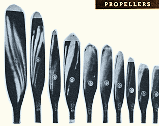 In the mid-1940s, toward the end of World
War II, Flying Aces magazine changed its name to Flying Age,
while changing its focus from model aviation to aviation in general. Much to the
consternation of many of its readers, that included no longer including the much-loved
fictional stories of flying superstars like Kerry Keen, Dick Knight, Capt. Philip
Strange, Battling Grogan and his Dragon Squadron, Crash Carringer, and of course
Lt. Phineas Pinkham. The good aspect of the change is that Flying Age
published a lot of stories about full-size aircraft and flying which were geared
toward their audience of modelers who were interested in all aspects of aeronautics.
This piece discussed primarily
variable pitch, constant speed propellers being used on military, commercial,
and civilian airplanes. You, like I, though that by now there would be similar propellers
available for model aircraft use, but apart from a few homebuilts, no commercially
made products are available (there was one for indoor electrics, but nothing for
powerful engines / motors). Given the number of variable-pitch rotor heads for helicopters,
it shouldn't be so hard to implement for airplane propellers... In the mid-1940s, toward the end of World
War II, Flying Aces magazine changed its name to Flying Age,
while changing its focus from model aviation to aviation in general. Much to the
consternation of many of its readers, that included no longer including the much-loved
fictional stories of flying superstars like Kerry Keen, Dick Knight, Capt. Philip
Strange, Battling Grogan and his Dragon Squadron, Crash Carringer, and of course
Lt. Phineas Pinkham. The good aspect of the change is that Flying Age
published a lot of stories about full-size aircraft and flying which were geared
toward their audience of modelers who were interested in all aspects of aeronautics.
This piece discussed primarily
variable pitch, constant speed propellers being used on military, commercial,
and civilian airplanes. You, like I, though that by now there would be similar propellers
available for model aircraft use, but apart from a few homebuilts, no commercially
made products are available (there was one for indoor electrics, but nothing for
powerful engines / motors). Given the number of variable-pitch rotor heads for helicopters,
it shouldn't be so hard to implement for airplane propellers...
|